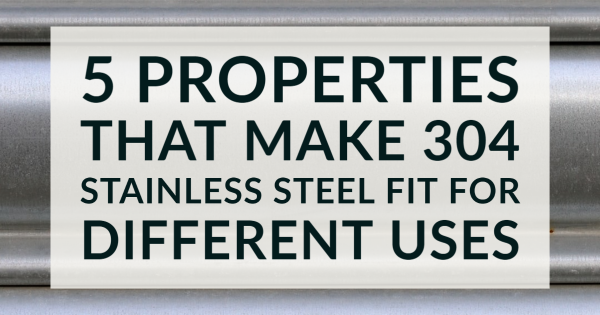5 Properties That Make 304 Stainless Steel Fit for Different Uses

One of the most versatile and useful grades of stainless steel is 304 stainless steel, commonly referred to as 304 stainless. Type 304 stainless is the most common grade of austenitic stainless steel in the T 300 series. 304 stainless is the standard “18/8” stainless that is largely used to make household equipment such as cookery tools, and industrial applications such as fasteners and machinery parts. What qualities make 304 stainless so useful?
Chemical Composition
Type 304 stainless is composed of different elements at varying percentages. The two dominant elements are Chromium and Nickel. The minimum amount of Chromium you’ll find in 304 stainless is 18%, while Nickel accounts for 8% at the minimum. This is what informs the denotation “18/8” stainless steel. Other elements present in 304 stainless steel include carbon (0.098%), Nitrogen (.10%), Sulfur (.030%), Phosphorus (.045%), Silicon (.75%), and Manganese (2.00%).
Corrosion Resistance
Type 304 stainless is corrosion resistant in many environments that other materials could be affected by rust. For instance, the Marine Environment. The chromium added in steel alloys is what gives 304 stainless steel its corrosion resistance. Stainless steel is an alloy of iron, and the presence of Chromium prevents rusting. That’s why many equipment and machinery used in the Marine environment, outdoors, and in the kitchen are made from stainless steel. Otherwise, this equipment would be highly susceptible to rusting because they are frequently exposed to water and moisture. Additionally, 304 stainless is resistant to the moderately aggressive organic acids, thanks to the 8% Nickel composition. The corrosion resistance of 304 stainless steel increases its utility in different environments. Even more, it helps preserve and maintain the aesthetics of equipment by preventing rusting.
Good Welding Properties
Again, the presence of Chromium and Nickel in stainless steel makes it good for welding. Chromium facilitates ferrite formation that is very useful when welding. Using Grade 304L, the lower carbon version of 304 stainless, there is little or no need for post-weld annealing. This makes it suitable for use in high gauge components. The low-temperature properties of 304 stainless steel enable the hardening of welded parts and joints through cold working. Ultimately, welders find it easy to work with stainless steel because they can use any arc welding processes — MMA, TIG, MIG, and SA.
Easy to Clean and Maintain
The equipment made from 304 stainless is easy to clean using soap water. When you have tougher dirt accumulating on the stainless steel surface, you can use the regular detergent without damaging your equipment. The anti-corrosion properties of stainless steel make it easy to clean with soap and water without accumulating rust.
Aesthetic Appeal
304 stainless steel is attractive and gives products and equipment a good visual appeal. The shiny appearance of most cooking appliances such as pots and pans is due to the stainless steel. Given that 304 stainless is resistant to corrosion from acids found in vegetables, fruits, meats, and milk, it’s best suited to make most kitchen appliances.
There are different grades of 300 Series stainless steel austenitic. They include 302 stainless and 304 stainless. Type 304 stainless is widely used all over the globe because of its desirable qualities, such as corrosion resistance and good welding properties. Compared to other materials such as aluminum, copper, and brass, 304 stainless is most suitable for domestic and commercial uses. The majority of the everyday machinery, domestic appliances, and equipment utilize stainless steel. Today, it’s estimated that 40% of steel production across the world is made with recycled metal.


